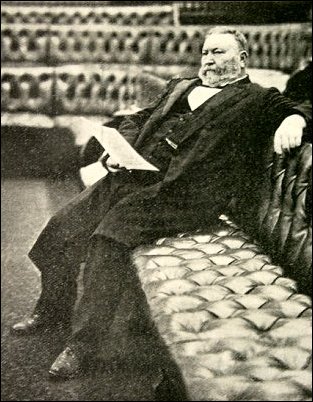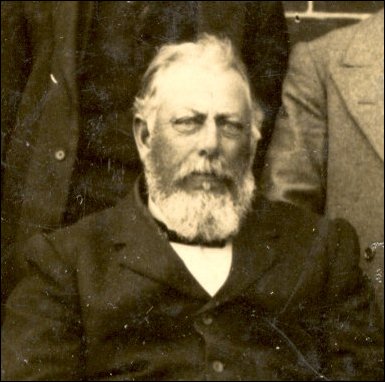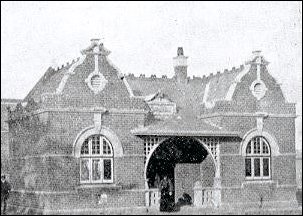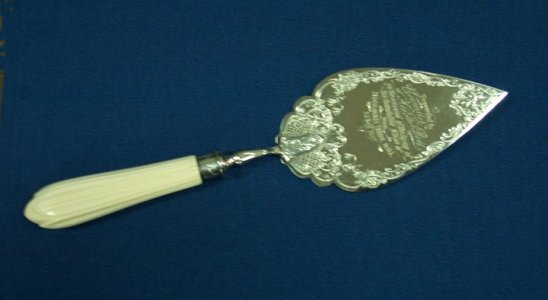The Push for a new Shire Hall, 1907

Demolition Work in 1961 reveals the façade of the earlier Shire Hall. Leader Collection.
The Moorabbin Shire Hall in 1888 was described as an ancient looking building, about which “the least said the better. The two rooms facing the street were used for small public gatherings and tea meetings while the council chamber was at the rear.” [1] This derogatory assessment was made despite an enlargement and refurbishment carried out four years earlier. The council officers, it was agreed, were working under impossible conditions and given this situation the Council resolved in December 1901 to enlarge and improve the current hall. To enable this resolution to proceed money was allocated in the estimates for the following year but the money was never utilized. [2] It was not until 1905 that the issue of the condition of the Shire Hall was raised again.
When the matter was brought up again the Councillors referred the matter to a committee which put forward two options. The first was to make an archway in the dividing wall between the council chamber and the public hall so the former section could be used for office work with the hall becoming the council meeting venue. The second proposal was to extend the council chamber by the addition of two offices about 15 feet by 10 feet. [3] A third possibility not put forward by the committee was to pull the old shire hall down and build a new one at Cheltenham or some other place, an option that several councillors preferred. The resolution of this issue was to take several years and involved the councillors in acrimonious debate.
Cr Burgess moved on November 11, 1905 that the first option be adopted but Cr Ferdinando of Sandringham challenged this, believing some estimate of costs needed to be obtained before a decision was made. He took the opportunity to advise his colleagues to look to the future, suggesting the possibility of Sandringham splitting off from Moorabbin to form its own shire would influence the decision. Given this scenario he thought a more suitable site for the Shire Hall would be found at Cheltenham or Mentone. In the meantime, Ferdinando suggested a temporary solution. He said a partition down the centre of the council chamber would give officers more space and allow council to meet in the hall. Cr Scudds of Mentone and Cr McIndoe of Mordialloc supported their colleague from Sandringham but the final decision was to postpone the matter for a month. [4]
The next week a public meeting was held at the Mentone Recreation Hall to protest against the proposed additions to a Shire Hall at South Brighton, a building that one participant saw as “obsolete, useless and too far away”. Now was the time to site the hall more conveniently for the majority of the population, one speaker suggested. Cr Brownfield said he knew about the time wasted by councillors who had to walk four and six miles after meetings. [5]
Mentone was promoted as the best site by Mr W Wharington, a Mentone resident who suggested the Mentone Skating Ring as being most suitable as the property was already owned by the Council. It was also a brick building in good condition and contained four large rooms. Another Mentone alterative was to build the necessary offices in front of the Recreation Hall at a cost not exceeding £200. Cr Scudds thought it highly unlikely that the majority of ratepayers would vote solidly for the hall at Mentone, but it was a mistake to think a large sum of money would be spent on it. He had previously advocated that the Council Chambers and offices be moved to Cheltenham’s Orderly Room, a more central location, but this was ridiculed by Cr Bent as a ‘skalliway’ suggestion. [6]
The managing trustee for the Protestant Alliance Society added to the debate by offering for purchase the Orderly Room at Cheltenham for £700, the payments to be made in any manner the Council wished. [7] It was pointed out in his letter to Council that the building originally cost £1800 and was in first class condition. Both Cr Scudds and Cr Penny were supporters of this option which Penny described as “a gift at £700” but no action was taken. [8]
Cr Bent, the Premier of the State, had not been in regular attendance at Council meetings due to pressure of parliamentary duties but he was at the last meeting of the Council for 1905. While speaking about expenditure on roads he digressed to suggest that a Mechanics’ Institute might be connected to the municipal building, and he subsequently moved a motion that £600 be spent on the building; £400 to be the Council’s contribution, £100 raised by the residents and £100 to be provided by the government. Cr Scudds immediately sought clarification of Thomas Bent’s proposal – was he suggesting £400 be spent on the Brighton South Hall or on a Mechanics’ Institute? Bent answered, “No, only part of it; every place has a Mechanics’ Institute.” He pointed out a portion of the money could be for a Mechanics’ Institute and the rest for the Municipal Offices [9]

Sir Thomas Bent in Parliament House Melbourne, 1900.
Bent’s action supported by Cr Mills brought an immediate negative response from Scudds and Ferdinando. Scudds repeated his view that Cheltenham was the better location for the Council offices and shire hall. Ferdinando was against spending the amount of money proposed stating that with the use of partitions the hall could be made suitable for Council officers for £20 or £30. A Mechanics’ Institute at South Brighton
would not pay expenses of the librarian, lighting, etc, he claimed as he asked where the money was to come from to support the operation. Other councillors spoke either in support or against the proposal but once more the matter was not resolved, it being deferred until the next council meeting. [10]
The people of South Brighton reacted quickly on receiving news of Bent’s suggestion that a Mechanics’ Institute and library should be established together with an improved shire office, and his idea that if the community raised £100 the government would match it. When making this proposal he said he believed in the policy of helping those who were prepared to help themselves. [11] A public meeting chaired by Dr Joyce with Mr Saunders as secretary attracted thirty ratepayers. There the option of purchasing the Protestant Hall at Cheltenham was ridiculed on grounds of cost, and the argument that the shire offices should be at Cheltenham because that was the business centre of the district was debunked. Before the end of the meeting £40 was promised and at a follow-up meeting an additional £20 was found. [12]
At the next council meeting councillors once more rehearsed their reasons for or against an expenditure of £400 of council funds to extend shire facilities. Bent, in an expansive speech, pointed to the money spent in other parts of the district and the need to have a safe place for council records and somewhere where the young people could read newspapers and magazines to enhance their intellectual growth. He then moved that £400 be provided by the council for improvements to the shire hall and the provision of a mechanics’ institute, provided the residents raised £100. In addition he suggested the Government to be asked to contribute £100.
Cr Ferdinando speaking against Bent’s motion said two propositions had to be addressed; one to spend £400 of ratepayers money, and another to spend £200 on a mechanics’ institute. He had no objection to the latter but opposed spending £400 on the present shire hall. [13] Despite Ferdinando’s claims and support from Cr Scudds the motion was carried seven votes to five. Bent, Penny, Barnett, Mills, Burgess, and Small voted for the motion, and Scudds, Ferdinando, LePage, McIndoe and Brownfield against. [14]
At the first meeting of Council in February 1906 the councillors were informed by letter that the residents had raised the required £100 and were ready to pass it across on the condition that the Mechanics’ Institute was connected to the hall. The anti group queried where the £400 council contribution was to be found and pointed out that the projected expenditure had not been placed in the estimates for that year. Cr McIndoe raised a new complication, drawing attention to a resolution ‘on the books’ that £120 be spent on the hall and that decision had not been rescinded. [15] This sent the secretary searching to check the accuracy of Cr McIndoe’s statement.
Cr McIndoe was proved to be correct although it was £150 that was set aside in the 1902 estimates to enlarge the Shire Hall but never spent. [16] Given this situation, it was argued, the resolution had lapsed leaving the way clear to proceed with the substance of Bent’s motion. Cr Bent took the opportunity to propose the ratepayers be asked for the £100 they were to subscribe towards the expenditure, saying he was not in favour of the matter proceeding without the ‘sugar’. He even suggested without it he would go across to the Ferdinando party to accompanying laughter from his colleagues. Mr Reynolds, on behalf of the South Brighton committee, handed across the cheque for the £100 saying he was glad to get rid of it. [17]
The arguments for and against the Bent proposal continued, often regurgitating matters raised once or twice before. Cr Burgess was concerned about the safety of council records which were increasing in number. He believed the councillors had a responsibility to the ratepayers and themselves to see them placed where they could not be burnt or stolen. Cr Ferdinando at a Sandringham public meeting of ratepayers from the West Riding pointed to the disgraceful state of roads and drains and the debit balance of the riding’s finances. He recognized the needs of the South Brighton residents for a Mechanics’ Institute and suggested they should be given a portion of the Shire Hall land to build a hall and recommended they be charged one shilling per year rent. Mr Reynolds of South Brighton pointed out that his fellow residents had to go to Cheltenham to obtain a suitably sized hall for meetings because the population in the riding had increased.
The Sandringham meeting ended in some disarray after Cr Clements, the Shire President and chairman of the gathering, seizing his hat and coat, declared the meeting closed and left to the annoyance of Cr Ferdinando who believed the business of the meeting had not concluded. Under the newly elected chairman, Mr Chambers, the meeting continued and moved and carried a motion requesting the councillors of the West Riding to oppose the spending of £400 on the Shire Hall at Brighton South. [18]
By the beginning of 1907 the matter was resolved. The shire hall was to remain in South Brighton with £800 being provided to ensure that the building was “up to date and an ornament to the shire.” An additional £100 was promised by the Premier and a further £100 was to be raised from residents. Cr Burgess moved that the secretary instruct Mr Schrieber to prepare a rough plan of the shire hall improvements at a cost £800, and said the work should start at once in fairness to residents. Cr Mills, probably reflecting on the time taken to reach this stage, when seconding the motion pointed out that some of the councillors were getting old , and they would like to enjoy the comfort of the new building for a while. [19]

Cr R A Mills.
At the next meeting of council sketch plans of the new Shire Hall were displayed and some arguing took place between councillors as to whether the slate from the old building should be used on the roof or whether tiles should be used. There was also discussion about the location and lack of connection between the offices of the rate collector and engineer. [20] However, by May steady progress was being made by the workmen under the supervision of Mr Tait, one of the contractors, [21] and by September questions were being asked as to when the hall was to be opened. [22]
Cr Clements pointed out a cavity had been left in the front wall of the building to allow a stone to be placed there bearing the names of councillors, secretary and the member for the district. The discussion then turned on whose name should appear on the tablet as president of the shire. Cr Brownfield was shire president during the major part of the hall’s construction but Cr Small was the president when the hall was opened. Cr Ferdinando moved that Cr Brownfield’s name should appear as president as evidence of good will and courtesy, a suggestion which Cr Small supported. But when Cr Brownfield objected the original suggestion was withdrawn. It was resolved however to invite Thomas Bent, the Premier of Victoria, to open the new building because of his long association with the district. [23]

The Moorabbin Shire Hall, c1908.
September 25, 1907 was the day the official opening took place. More than four hundred people were waiting for the arrival of Thomas Bent from the Western district, including a guard of honour composed of the South Brighton cadets under the charge of Lieutenant Collens. The Mayor and Mayoress of Brighton were there together with the Moorabbin councillors. Inside the hall Di Gilo’s band was playing ‘tuneful music’ when the Premier arrived ‘looking rather tired’. [24]
Thomas Bent launched quickly into his speech drawing upon his memories of the early days of Moorabbin, the election of the Roads Board, the absconding of Joseph Ostler the district secretary, and the appointment of Colonel Mair the chairman. He also alluded to the recent moves of Sandringham residents to secede from of the shire and form their own local government district. He hoped that the little friction that existed would dissipate and that all districts would work together to make Moorabbin one of the finest shires in the State. With that he proceeded to lay the stone using an inscribed silver trowel, remarking as he did so that Cr Small should have been undertaking the task, but he deeply appreciated his kindness in allowing him to do so. He concluded with the words: “I declare this stone well and truly laid.” [25]

Silver Trowel used by Sir Thomas Bent in laying the foundation stone to the 1907 Shire Hall. Inscription reads: Presented to Councillor Hon Thos Bent on the occasion of the laying of the Foundation Stone of the Moorabbin Shire Hall, 25 Sept. 1907.
The outdoor ceremony finished, the company moved into the hall where Thomas Bent spoke again and declared the hall open. Mr Bent recalled, “I have been connected with this land for over forty years. We purchased it from Mrs Bryant. You don’t remember her I suppose? But she was a very rich widow, and she got 100 sovereigns for the land.” He went on to suggest that children should not forget the contribution of the pioneers adding, “Why I remember when we had to walk up to our knees in sand, and had to pay 3/6 to go to town. … I hope that this district will progress in such a manner that this hall will not be half large enough”.[26] Bent’s wish for the district did come true but not for many years later.
Footnotes
- Leader, October 13, 1888.
- Moorabbin News, February 24, 1906.
- Brighton Southern Cross, November 11, 1905.
- Brighton Southern Cross, November 11, 1905.
- Moorabbin News, November 26, 1905.
- Moorabbin News, November 25, 1905.
- Moorabbin News, December 9, 1905.
- Moorabbin News, November 25, 1905.
- Moorabbin News, December 23, 1905.
- Moorabbin News, December 23, 1905.
- Brighton Southern Cross, January 20, 1906.
- Brighton Southern, Cross, January 13, 1906.
- Brighton Southern Cross, January 20, 1906.
- Moorabbin News, January 20, 1906.
- Moorabbin News, February 10, 1906.
- Cr McIndoe had thought the amount of money was £120 but the check of the records revealed it was £150.
- Moorabbin News, February 24, 1906.
- Moorabbin News, March 31, 1906.
- Moorabbin News, January 26, 1907.
- Moorabbin News, February 23, 1907.
- Moorabbin News, May 25, 1907.
- Moorabbin News, September 7, 1907.
- Moorabbin News, September 28, 1907.
- Moorabbin News, September 28, 1907.
- Moorabbin News September 28, 1907.
- Moorabbin News, September 28, 1907.
